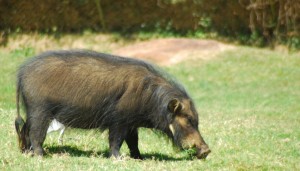
Forest Hog, Hylochoerus meinertzhageni is the largest wild member of the pig family, Suidae. It is most common near permanent water sources, especially where there is a thick understory cover. The rimator subspecies is found in the highland forest in the Cameroonian border of Nigeria. Standing approximately 1m high and 190 cm long, adults have a huge broad head, and males have pads of naked, inflated skin near their eyes. Mature males are considerably larger than females and have enormous naked cheeks, a broad flat muzzle and tusk. The female has a hairier and more slender face with much smaller tusk.
Coprophagy, the consumption of the feces of other animals, because they contain amounts of semi-digested food, is found in forest hogs. The giant forest hog is mainly a herbivore, but also scavenges.
The Nigerian population may be an isolated one. It is usually considered nocturnal, but in cold periods it is more commonly seen during daylight hours, and it has been suggested it is diurnal in regions where protected from humans. As all suids of Sub-Saharan Africa, the giant forest hog has not been domesticated, but it is easily tamed and has been considered to have potential for domestication. Gestation period in the forest hog is approximately 151 days. Two to four litter with almost as high as ten piglets in a litter are produced. Sexual maturity is attained at 18 months. The hog lives averagely for 5 years in the wild, though 18 years lifespan have also been recorded.





















